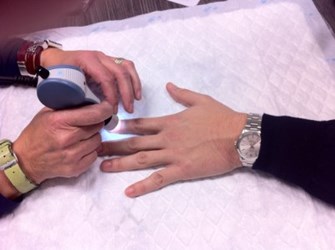Non-Invasive Device Could Allow At-Home White Blood Cell Monitoring

An international consortium of researchers has developed a novel method for counting white blood cells without breaking the skin. The portable device, which counts leukocytes through the skin as they flow past a miniature lens, could give immunosuppressed patients a less painful option for their regular lab workups and may allow doctors to more closely tailor cancer treatments for leukemia and lymphomas.
Patients with suppressed immune systems due to chemotherapy, or patients taking immunosuppressant drugs for diseases like rheumatoid arthritis, often need to have their white blood cell counts monitored to make sure that their immune system doesn’t dip to dangerous levels, a condition called leukopenia. Such a dip leaves the patients vulnerable to infection, which could delay treatment or necessitate hospitalization. Checks for leukopenia have traditionally required a blood draw.
A consortium of scientists from Madrid and Boston, including the Massachusetts Institute of Technology (MIT) —called Madrid-MIT M+Vision — has been working on a non-invasive test that would allow patients to monitor their own white blood cells from home and eliminate hassle of traveling to a lab or the pain of being stuck with a needle.
Carlos Castro, a biomedical engineer at MIT, told Sinc that he envisions a day where immunosuppressed patients use a “leukometer” at home the same way diabetics use a glucometer. Such a simple test at home, said Castro, would allow patients to monitor their immune systems more closely, “detect leukopenia earlier, and avoid its consequences.”
Similar to a pulse oximeter, the researchers’ project, called Leuko, attaches to the fingertip and uses certain frequencies of light to illuminate capillaries in the nail bed. While red blood cells absorb the light, white blood cells do not and appear transparent. Images collected by a small lens are analyzed by a computer algorithm that counts the transparent sections to give an accurate reading of white blood cell activity in the blood stream.
Portable at-home white blood cell monitoring, said Castro, offers many advantages currently unavailable. It could sound an early alarm of sepsis, and it could allow doctors to tailor medications post-chemotherapy to best suit the recovery times of the patient.
“Treatment doses could be maximized for each individual without compromising their immunological system. Treatment efficiency could be improved while reducing the risk of suffering serious infections,” said Castro. “These decisions are not currently possible because it is not feasible to call patients in every hour or every day to test their blood.”
Recent trends toward at-home treatments and self-monitoring systems have presented significant growth potential for needle-free technology, especially for those with chronic conditions that require regular checkups. A study published last year in Innovations in Pharmacy listed increased compliance, feasible self-administration, and safer disposability as advantages to needle-free treatment and diagnostic options.
Castro told Sinc that his team is working on several different protypes, including a smartphone version of the device. He projects that, with adequate funding, Leuko could be on the market as early as 2019.
